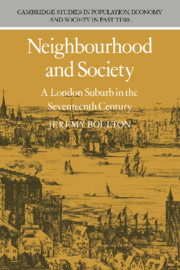Book contents
- Frontmatter
- Contents
- List of figures
- List of tables
- Preface
- Abbreviations
- 1 Introduction
- 2 The demographic background
- 3 Earning a living in early seventeenth-century Southwark
- 4 Wealth and social structure
- 5 Household structure and the household economy
- 6 Power, status and social mobility
- 7 Residential patterns and property ownership
- 8 The dynamics of a local community
- 9 Social relationships in the urban neighbourhood
- 10 The institutional structure of the neighbourhood
- 11 Conclusion: neighbourhood and society in seventeenth-century London
- Bibliography
- Index
4 - Wealth and social structure
Published online by Cambridge University Press: 19 October 2009
- Frontmatter
- Contents
- List of figures
- List of tables
- Preface
- Abbreviations
- 1 Introduction
- 2 The demographic background
- 3 Earning a living in early seventeenth-century Southwark
- 4 Wealth and social structure
- 5 Household structure and the household economy
- 6 Power, status and social mobility
- 7 Residential patterns and property ownership
- 8 The dynamics of a local community
- 9 Social relationships in the urban neighbourhood
- 10 The institutional structure of the neighbourhood
- 11 Conclusion: neighbourhood and society in seventeenth-century London
- Bibliography
- Index
Summary
Society and social groups in London
It has become a truism that the predominant feature of English society in the sixteenth and seventeenth centuries was social inequality and that social stratification ‘the inequalities that arise from the organisation of people in society’ was commonly recognised and described by contemporary commentators. Individuals such as Sir Thomas Wilson or William Harrison conventionally devised hierarchical social rankings in order to classify society's members. Such schemes normally referred to adult males and excluded all women. These pictures of society tended to focus particularly sharply on the higher social groups, reflecting the social perspective of the author, and often lumped the lower strata together, so that finer social gradations that may have existed among these groups are lost.
The social stratification of seventeenth-century rural society seems to be well established. Within village society social stratification was determined largely by wealth. Social status, an individual's ascribed position or standing in that society, and participation in positions of authority followed the same pattern. Furthermore the occupational descriptions: yeoman, husbandman and labourer, did indeed broadly correspond to real social and economic differences in village society. However this is not to say that wealth did not overlap between these social groups, that they were discrete social ‘estates’ or that they did not encompass considerable regional variation. It is then perhaps symbolic that the 1533 Act of Apparel, widely publicised in repeated proclamations, divided English society according to income levels rather than the social classifications of unpublished contemporaries.
- Type
- Chapter
- Information
- Publisher: Cambridge University PressPrint publication year: 1987

